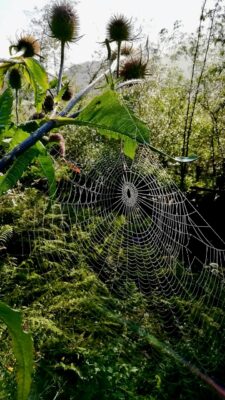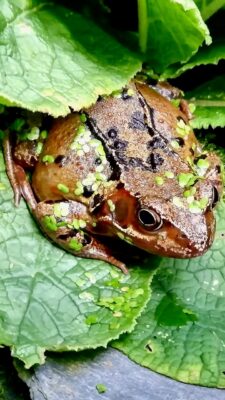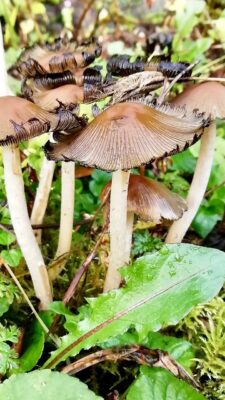For passing wild life, a garden made in nature offers a welcoming stopover – and for the gardener, there is the joy of myriad encounters with the creatures that share our world.
A gang of long-tailed tits has just swept through my garden on a tepid February breeze, lit up by milky, spring-is-around-the-corner sunshine. Darting from naked twig to twig, tsurp-tsurp-tsurp as they go, they foretell the turning of the season (not that this spring hasn’t already put in several cameo appearances well before winter’s end). The restless titmice don’t dally; they’re one example of the just-passing-through, wild, untamed life that threads itself over, under, around and through the garden.
Here on the edge of woodland, my garden has literally been made in nature, bringing challenges, but also two decades of utter delight. Much of that delight has grown from a quiet realisation that my garden and greenhouse – as well as my home and I – are actually in the way of the flow of wild lives all around us.

We sit like a rock in a stream, diverting the bustle around us, speeding it up here, slowing it into swirling eddies there, subtly altering the course of things. We rub along happily amid the wildness, my garden and I more than making up, hopefully, for our gentle, benign obstructiveness.
As the titmice gambol away, a motley band of blue, coal and great tits flits through the stirring hazels and willows, hunting early bugs rising on the mildness. In colder snaps, packs of quarrelsome siskins descend on the alder, prising seeds from its brown cones. Scolding wrens dart low under the brambles on the garden’s periphery, then circle the honeysuckle-wrapped leaf mould cages, reminding me that I’m pitched up on their patch (the tables briefly turn each time a wren goes fly-hunting in my greenhouse…).
Dashes of gold, red and white alight on the winter-weathered teasels, goldfinches finally making a stopover to feast on their seeds (they’ll be back soon for green, pre-flight dandelion tucker). Come what may, I can’t tempt the fly-past flocks of redwings or fieldfares (sometimes a mix), because I don’t have enough hawthorn berries on offer. I’m content watching them strip my neighbour’s bushes, in minutes, before moving on.
In another month or so, it’ll be smash-smash-smash time, when thrushes and blackbirds alight on slate anvils to prise snails from their shells. I wish they’d devour the slugs, which, lured from my mulched, no-dig beds by the warmth, are decimating the daffodils – but no, they’ll wait until the beds are spruced up for spring, then flick the woody, life-filled mulch over the paths in search of molluscs. I’m in their way again, but they get nosh out of it and I get the joy of watching them.

Other life flows unseen below the mulch. Common voles run just under the surface, where they nibble roots and sometimes dash out to gnaw through seedling stems, always just below the seed leaves. Did I mention the challenge of garden-making in nature? Vole philosophy is this: the gardener creates terraced beds using slate, with lots of nooks and crannies, filled with nice loose soil for us, shrews and mice, so we’ll inhabit it. We rub along, me cursing over another nipped-off cosmos (or ten). Note to gardener: raise plants in pots, and let them get bigger before planting out.
Revenge does come – not from me, but from a mammal able to flow like quicksilver between the gaps in the slate walls just like a vole or mouse: the weasel. At last, a wild animal that’s glad I’ve got in the way and designed it a perfect hunting ground. You’re welcome, Mustela nivalis, come again soon. My patch is your platter.

Also and especially welcome are slow worms and common lizards. Both are prolific, permanent residents here, their numbers increasing as the garden has taken shape. Hot slate is sun-basking summer heaven for these cold-blooded reptiles that make my patch their home. Unlike much wild life, they stick around, benefiting from the fact that there’s actually a garden here, as it’s now a mix of smaller habitats, each intertwined with the next, which is more ecologically diverse than the bracken-riddled bank it’s been fashioned from. Watching a laid-back lizard picking off ants, while basking atop an anthill, always brings a smile; I feel much more an ally than an obstruction.
Nature’s ally mode is what led me to put in my small pond – a self-contained living ecosystem in its own right. Aside from a small stream below the garden, there was no open water before the garden came about, so I’ve chalked the pond up as a win-win for both nature and gardener. Big fat frogs cool off here, newts cavort, bees stop to drink (voles, too, bless them), damselflies scope it out, while adult gnats and mosquitoes emerge as airborne food for bats. A heron dropped by once, a real and, on lift-off, startling treat.
Big, obvious wild life is unmissable, but I’m mindful of the intricate, criss-crossed web of life pulsing away under my garden; the roots of nearby sessile oaks, hazels, hollies and willows, plus those of the plants I grow; the tireless work of earthworms and other soil fauna; and the multidimensional web of fungal mycelium linking it all together.

I’ll never know if the barely understood subterranean world sees me and my garden as a barrier, but if the plants I grow are anything to go by, I’d say we’re getting along OK. I aim to tread lightly, in every sense.
Frequent flushes of toadstools tell me that fungi are flourishing in the beds where I’m building up fertility and humus using green wood chips; the decaying chips, wrapped in pale hyphae – that delicious mushroomy smell! – are creating soil while sinking away a little carbon. So perhaps it’s an advantage to fungi to have this gardener around, helping to nourish and build earth’s own living internet. The pollen- and nectar-rich dahlias and other flowers (dandelions very soon), nourished by my fungi-filled soil, refuel and sustain insect visitors – hopefully another good reason for me and the garden to be here in the non-stop flow of wildness.
Dusk falls as the titmice make a final sweep. A blackbird ruckus erupts in the wood – likely a prowling cat. Tawny owls call unseen from the oaks. To the vole peering from its nook, I’m a blur. Teck teck teck from a restless wren is all the hint I need: time to shove off.
Text and images © John Walker
Find John on X @earthFgardener


